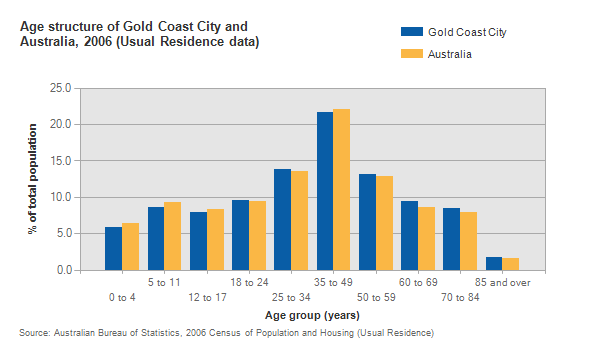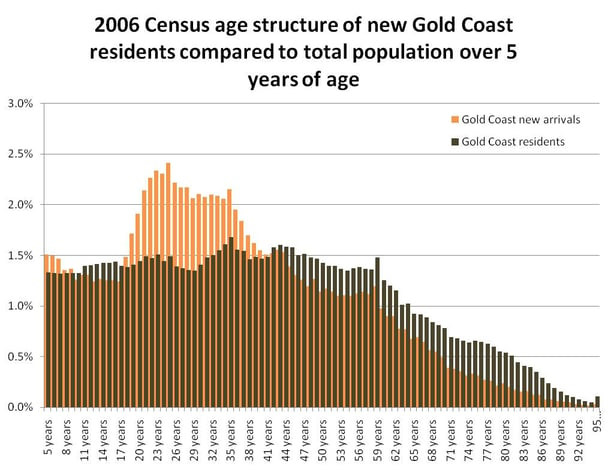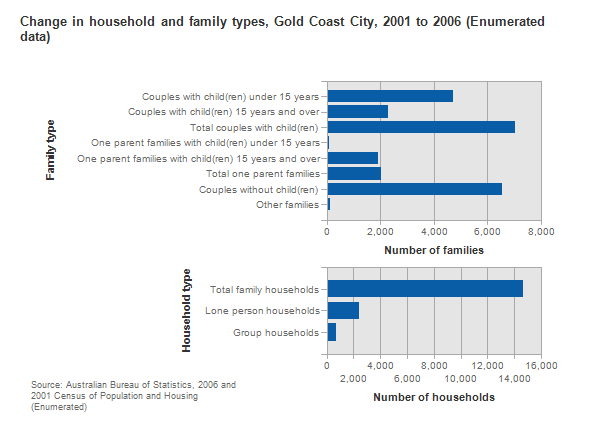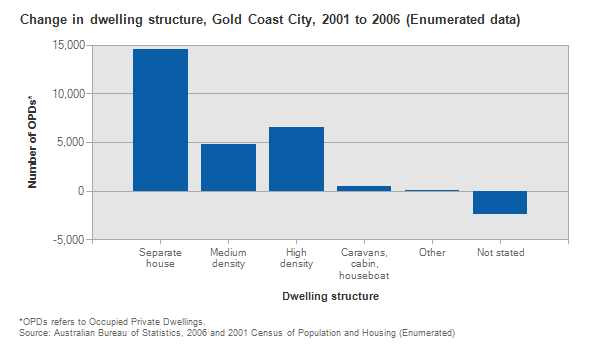The Gold Coast is an iconic Australian place, which most Australians have some familiarity with. As of June 2009, the Gold Coast was the largest non-capital city in the nation, and the 6th largest city over all, with 578,000 people (including the Tweed area in NSW), and growing faster than any of the state capitals, and any other city in Australia with a population over 100,000 people, with the exception of Cairns.

Who is moving to the Gold Coast? Most people will tell you it’s retirees. What does the data reveal?
The Gold Coast attracts people from all over the country to live. When you look at one of .id’s migration tables for almost any other Local Government area, the Gold Coast will pop up as place to which they have a net population loss – ie. almost everywhere in Australia there are more people moving to the Gold Coast than moving from the Gold Coast. One of the most common responses we get when we show people this population loss at profile.id staff training sessions is “Oh, everyone is retiring to the coast, it’s all our older people”. While this may have been true 20 years ago, in recent years much of the migration to the Gold Coast has been among the young, and particularly family groups.
How old are they?
Firstly, let’s have a look at the age structure of the Gold Coast. Compared to Australia, there are a few more people over 60, but mostly the structure mirrors the Austalian average.

Change in the 2001-2006 period shows an increase in all age groups, but particularly 35-49 year olds, and older children – family groups. Gold Coast is consistently adding about 15,000 people every year, and this shows no sign of letting up.
The Gold Coast is also attracting many young people now, with increasing employment opportunities and a university. This migration table shows a net gain of 6,623 15-24 year olds in five years and that most of the people moving in are under 55 years old.
The chart below shows the age structure of people who moved to the Gold Coast between 2001 and 2006, compared to the total resident population of the Gold Coast. This shows that the peak of the in-migration is between the ages of 20 and 40.

What is the typical household/family type?
One of the most interesting things about the Gold Coast’s population is that between 2001 and 2006, the average household size actually increased. During the past 30 years or so, average household size in Australia has been falling, as empty nesters begin to dominate the population, people have been marrying later, having less children, choosing to live alone etc. This trend slowed in the 2001-2006 period, but the average household size for Australia still fell from 2.60 to 2.55. At the same time the average household size on the Gold Coast rose from 2.47 to 2.49, not a huge increase, but bringing it closer to the Australian average. This is not in keeping with a retirement based community which usually has falling average household sizes.
In fact the chart below shows that the largest emerging household type on the Gold Coast is couples with children, just outnumbering couples without children.

All this indicates that the Gold Coast is moving from a holiday and retirement destination, mainly attracting empty nesters, to come of age as Australian city in its own right with a diverse mix of households.
This finding is confirmed when you look at the change in housing stock which shows the strongest growth is in separate dwellings (usually consumed by families) rather than high density developments.

Most of the growth is not along the coast itself, but in the Gold Coast’s own version of Southern California’s “inland empire”. Suburbs such as Pacific Pines and Upper Coomera have grown rapidly and predominantly feature family housing.

Where are all these people coming from?
Only about 3,000 people per year is accounted for by “natural growth” – or the number of births minus deaths. The rest are all migrating in. Between 2001 and 2006, around 27,000 people migrated to the coast from overseas (though some also left, and we don’t have those numbers). Predominantly, the overseas born are from English speaking countries (New Zealand, UK, South Africa), plus Japan. In fact there were over 32,000 New Zealand-born residents living on the Gold Coast in 2006, 7.5% of the population!
But the largest trend in Gold Coast population growth is migration from interstate, and while it gained population from all states and territories, the lion’s share comes from New South Wales. A quick glance at Gold Coast’s migration table (01-06) shows that it gained over 20,000 people from NSW as a net figure (includes in and out migrants).
And the top areas? All from Sydney, and predominantly the outer suburbs, places such as Sutherland Shire, Penrith, Blacktown, Warringah and The Hills Shire. Look at the migration tables for any of these councils, and Gold Coast features among the top places their people are moving to, in some cases the number one destination. There are a number of factors to this, most likely housing cost and lifestyle issues had a major impact – prices in Queensland were significantly cheaper than Sydney in the 2001-6 period, though the gap has closed since.
Recent data on building approvals shows a significant slump on the Gold Coast due to the GFC, but according to the ABS, population growth has continued unabated at over 15,000 per year, so it will be interesting to see what affect this has on the data from the 2011 Census. Watch this space.
.id is a team of demographers, population forecasters, spatial planners, urban economists, and data experts who use a unique combination of online tools and consulting to help governments and organisations understand their local areas. Access our free demographic resources here















